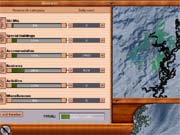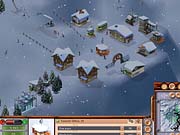Ski Park Manager is similar in many ways to other recent resort management games, and true to its name, it lets you build and manage your own ski resort. Unfortunately, what is otherwise an enjoyable and challenging game with an interesting premise is hidden beneath an unintuitive interface, questionable design decisions, compatibility issues, and an overall lack of polish. In addition, the absence of any kind of tutorial ensures that you will be forced to wrestle with the game until you either learn to work around the shortcomings through trial and error or give up and move on to something else.

You begin the game with an underdeveloped mountain area and a set amount of money--based on the difficulty you select--to invest in ski lifts, support buildings, landscaping, and other ski resort features. Each scenario has a list of objectives, including a required number of ski lifts and visitors, visitor approval percentage, and profit. Once you have selected one of the various mountain areas to use, you position ski lifts, lay out ski runs, construct housing and support buildings, and hire staff to help run the resort. When the park is opened for business, visitors will trickle in and use the facilities, and you will collect money from admissions, concessions, ski rentals, housing, and the other businesses you have built in the resort. The success of your resort depends on the happiness of your visitors, and the happiness of your visitors depends on the quality of your ski runs and other resort features.
The game's 3D terrain engine lets you view your mountain only from four preset isometric angles, which can make it difficult sometimes to get a sense of the mountain's contours. Likewise, the lack of a usable overhead view can make it difficult to lay down ski lifts and runs, since it is unclear which sections of the mountain are higher than others. The game's optional grid view helps to a point, but you'll still find yourself ending up with ski runs that aren't exactly what you expected them to be.
Another part of the game that isn't entirely clear is the ski run construction tool. The tool lets you choose which level of difficulty you wish to designate the run, and you string together sections of the run by clicking your way down the mountain. When a particular section is unusable, part of the highlighted section will turn red, which indicates a conflict of some sort. Often, this will mean that you inadvertently guided your ski run through a building or other structure, but occasionally it will turn red for no apparent reason, forcing you to change your ski run layout or even abandon the run altogether if an alternative cannot be found.

The game's graphics do a mediocre job of conveying the information necessary to build and manage your resort. On one of our test systems, the pointer icon actually covered up important pricing information, and while the game includes an adjustable view, none of the zoom options provides an appropriate angle for constructing a longer ski run, forcing you to frequently zoom in and out--and sometimes rotate--while placing a run or a lift. Support for higher screen resolutions or an overhead topographical view may have eliminated some of these issues. Unlike the graphics, the game's sound doesn't adversely affect gameplay, but it conveys the same lack of polish that reminds you that you're playing a budget-priced game. On top of these issues, Ski Park Manager had some problems running on one of our test systems that met the game's recommended requirements.
If you're willing to look past its shortcomings, the underlying game is actually fairly deep. The game begins with a basic set of resort improvements, and you can invest in research to develop new buildings, businesses, activity centers, lift types, and other features. You also have the option to buy advertising to attract different types of visitors to your resort. You can even pay to improve the skills of your employees through training. The number and type of visitors depends in part on a resort's reputation, which can be adversely affected by visitor injuries and deaths but also improved by young ski champions who train at the resort. The game also includes a wide variety of mountain areas to choose from when building your resort, and the difficulty settings give expert players a reason to play the same area more than once with different objectives. One feature that would have provided some additional play value is a sandbox mode for letting you build whatever resort you like without budget or research constraints.
While the game's numerous shortcomings detract from its appeal, serious fans of management strategy games who are tired of the theme parks and golf courses may enjoy the different challenges and premise found in Ski Park Manager. Those willing to put in the effort required to learn their way around the game's peculiarities will eventually uncover a fairly enjoyable game that had the potential to be very good. Those who don't have that kind of patience should instead pick up a more enjoyable budget-priced management strategy game.



